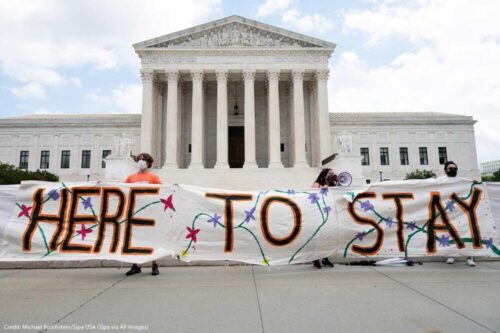
Photo provided courtesy of the American Civil Liberties Union (ACLU)
By Shreya Desai, Staff Writer
During Donald Trump’s presidency, the Deferred Action for Childhood Arrivals (“DACA”), has continuously been litigated. [1] DACA is a program that allowed undocumented immigrants who were brought to the United States as children to remain in the country and seek employment, which was established under the Obama administration. [2] To be eligible for participation, applicants must demonstrate that they had not been involved in the commission of any serious crimes, arrived in the country before the age of 16 and were no older than 30 at the time of application, and were in school, had graduated from high school or received a General Educational Development (GED) certificated, or were honorably discharged from the military. [3]
In September of 2017, Acting Secretary of Homeland Security (“DHS”), Elaine Duke, announced the rescission of the program, claiming that this was an unconstitutional exercise of power by the Executive Branch. [4] Following the issuance of the order, 15 attorneys general from various states [5] and the District of Columbia filed suit to stop the Trump administration from winding down DACA. [6] They contended that scrapping the program would damage states as DACA beneficiaries contribute to taxes, which go to state universities and other state-run organizations. [7] On the other hand, Devin M. O’Malley, a spokesman of the Department of Justice stated that despite the benevolent contentions of the states, DACA was an unlawful circumvention of Congress. [8]
Approximately four months later, Judge William Alsup of the United States District Court for the Northern District of California blocked the rescission, finding that the policy was not illegal. [9] Thereafter, in November of 2018, the Ninth Circuit Court of Appeals in San Francisco affirmed Judge Alsup’s order. [10] In June of 2019, the Supreme Court of the United States announced that it would hear the consolidated appeal of the Trump administration led by Department of Homeland Security vs. Regents of the University of California. [11] The issue on appeal was “whether DHS’s decision to wind down DACA is lawful.” [12]
Finally, on June 18, 2020, in a 5-4 decision, the Supreme Court stopped the Trump administration from immediately ending the program, ruling instead to protect approximately 700,000 “Dreamers” [13] from deportation. [14] The opinion of the Court authored by Chief Justice John Roberts was narrowly tailored: “The wisdom of [whether DACA or its rescission are sound policies] is none of our concern. Here we address only whether the Administration complied with the procedural requirements in the law that insist on ‘a reasoned explanation for its action.’” [15] Chief Justice Roberts also noted that there were no detailed justifications provided for the cancelation of the program during the three preceding years of litigation. [16] He added, “The basic rule here is clear: An agency must defend its actions based on the reasons it gave when it acted,” Chief Justice Roberts wrote. “This is not the case for cutting corners to allow D.H.S. to rely upon reasons absent from its original decision.” [17] Although the decision was based on technical grounds only at this juncture, it “allows Dreamers to breathe a temporary sigh of relief,” Professor of law at Cornell, Stephen Yale-Loeher stated. [18]
However, this sigh of relief may end sooner than some may have believed. [19] Since the Supreme Court decision, the Trump administration has announced new restrictions on DACA. [20] Immigrants already protected under DACA will be permitted to renew their status for one year instead of the two years originally allowed, and first-time applicants will be rejected from the program. [21] With strict eligibility requirements already in place, several have expressed concern over the new restrictions. [22] Juan Escalante, a Dreamer and FWD.us activist has made clear that “[n]o one here is going to get tired until we achieve permanent change and a path to citizenship.” [23] Despite the Supreme Court’s recent decision, it seems that litigation over DACA will continue for the time being.
[1] https://www.latimes.com/politics/story/2019-11-12/timeline-on-daca
[2] https://www.nbcnews.com/politics/immigration/trump-dreamers-daca-immigration-announcement-n798686
[3] https://www.nytimes.com/2020/07/28/us/politics/trump-daca.html
[4] https://www.latimes.com/politics/story/2019-11-12/timeline-on-daca
[5] The states included New York, Connecticut, Delaware, Hawaii, Illinois, Iowa, Massachusetts, New Mexico, North Carolina, Oregon, Pennsylvania, Rhode Island, Vermont, Virginia, and Washington.
[6] https://www.washingtonpost.com/world/national-security/attorneys-general-from-15-states-dc-sue-to-save-daca/2017/09/06/98bca3b2-930f-11e7-aace-04b862b2b3f3_story.html
[7] Id.
[8] Id.
[9] https://www.latimes.com/politics/story/2019-11-12/timeline-on-daca
[10] Id.
[11] Id.
[12] Id.
[13] Dreamers are the young immigrants who are impacted by DACA.
[14] https://www.npr.org/2020/06/18/829858289/supreme-court-upholds-daca-in-blow-to-trump-administration
[15] Id.
[16] Id.
[17] https://www.nytimes.com/2020/06/18/us/trump-daca-supreme-court.html?campaign_id=9&emc=edit_nn_20200619&instance_id=19532&nl=the-morning®i_id=101987120&segment_id=31329&te=1&user_id=26647bbfa44fa617de9492d28dc3d9a0
[18] Id.
[19] https://www.nytimes.com/2020/07/28/us/politics/trump-daca.html
[20] Id.
[21] Id.
[22] Id.
[23] https://www.nbcnews.com/news/latino/very-alarmed-dreamers-slam-trump-s-new-limits-daca-program-n1235184